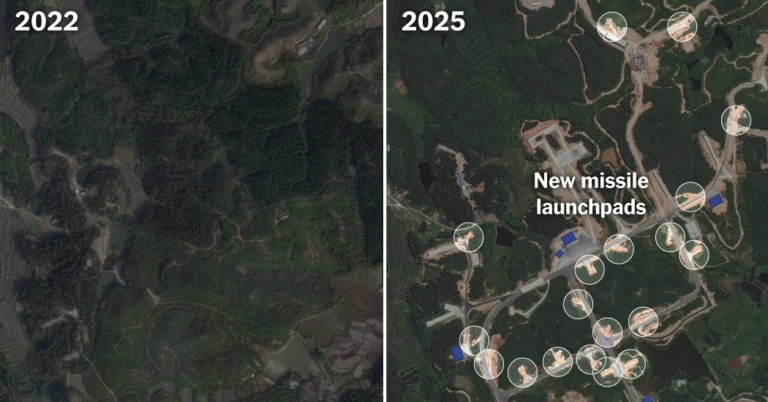China is actively developing its eastern coastline into a strategic missile launch zone aimed at Taiwan and the surrounding maritime areas. This expansion aligns with President Xi Jinping’s broader goal of asserting control over Taiwan and challenging U.S. influence in the Asia-Pacific region through a formidable display of military power.
According to Pentagon reports, China’s Rocket Force, responsible for managing both nuclear and conventional missile arsenals, has expanded its missile inventory by nearly 50% over the past four years, now estimated at around 3,500 missiles. Although the exact number positioned along the east coast targeting Taiwan remains uncertain, satellite imagery reveals the construction of larger missile bases and an increase in launch platforms in recent times.
The missile units stationed at these bases are equipped with cutting-edge weaponry such as the Dongfeng-17, a hypersonic missile known for its agility and difficulty to intercept, and the Dongfeng-26, colloquially dubbed the “Guam Express” due to its capability to reach U.S. military installations in the region.
Military personnel along China’s eastern shore have been conducting missile launch drills in diverse locations, including agricultural fields, remote valleys, highways, and coastal cliffs facing Taiwan, which is separated by a strait approximately 100 miles wide.
A Centralized Hub for Missile Operations and Training
Recent satellite data indicates that Brigade 611’s base has expanded to twice its previous size, incorporating what experts believe to be a comprehensive training complex featuring multiple launchpads and simulated tunnels for operational rehearsals.
Decker Eveleth, a specialist at CNA Corporation who has extensively analyzed China’s missile capabilities, describes the facility as a large-scale, integrated training ground designed to support a wide array of missile operations.
David C. Logan, an assistant professor at Tufts University, notes the unusually dense concentration of roughly 36 launchpads at this base, a departure from the typical practice of dispersing launch sites to reduce detection risks.
Similarly, Brigade 616 in Jiangxi Province has undergone rapid development. Satellite images from 2020 show that even amid the global pandemic, China was actively clearing farmland and constructing a new missile site, which neared completion within 18 months.
Advancements in Missile Technology
Experts, including Mr. Eveleth, suggest that Brigade 616 is being outfitted to deploy the Dongfeng-17 missile, capable of speeds exceeding Mach 5 and equipped with maneuvering abilities to evade interception. Specific structural features observed in satellite images, such as the height of storage facilities, support this assessment.
Brigade 611, visited by President Xi, currently fields the Dongfeng-26 missile, which can carry either conventional or nuclear warheads. Its nickname, “Guam Express,” reflects its reach to U.S. military bases across the Asia-Pacific. The missile’s road mobility complicates efforts to track and neutralize it. This brigade’s expansion was initially reported by researchers from the Federation of American Scientists.
The Pentagon estimates that approximately 500 Dongfeng-26 missiles are in the Rocket Force’s arsenal.
In the event of conflict, if Chinese leadership opts to arm certain Dongfeng-26 units with nuclear warheads, U.S. satellite surveillance might detect their movement from central China depots. However, experts caution that such monitoring is not infallible, creating ambiguity about which units are nuclear-armed, thereby increasing the risk of miscalculation and escalation.
Kelly Grieco, a senior fellow at the Stimson Center, emphasizes that any conflict involving Taiwan, especially with potential U.S. involvement, inherently carries a nuclear dimension due to systems like the Dongfeng-26, which significantly raise the stakes.
Chinese military doctrine and training videos reveal that in wartime, missile units would disperse to concealed locations such as caves and fortified sites to avoid detection. Coastal launch sites enable rapid strikes against Taiwan or naval targets, followed by swift relocation to evade counterattacks.
One notable launch site near China’s closest point to Taiwan was used during 2022 military drills, which Beijing framed as a response to a high-profile visit to Taipei by then-House Speaker Nancy Pelosi. Independent analysts, including Joseph Wen, identified this site through state media footage, confirming its role in testing missiles capable of reaching Taiwan.
China has also constructed realistic mock-ups of U.S. warships in its western deserts for missile targeting practice, including rail-mounted models that simulate moving vessels. In a conflict scenario, U.S. and allied forces would likely attempt to neutralize Chinese missile and long-range artillery units, though striking mainland targets risks significant escalation.
Chinese strategists appear confident that the sheer volume and mobility of their missile forces will outmatch enemy defenses, engaging in a strategic contest of evasion and attrition. Recent analyses highlight the vulnerability of U.S. air bases in Asia, which often lack sufficient hardened shelters to protect aircraft from missile strikes.
Thomas Shugart, a former U.S. naval officer and co-author of these studies, acknowledges ongoing efforts to bolster defenses but doubts they can withstand the overwhelming missile numbers China currently fields.
Despite rapid advancements, China’s missile program faces challenges. A Pentagon report has raised concerns about corruption within the Rocket Force potentially undermining the security of new nuclear missile silos.
Moreover, while improvements in radar and satellite technology have enhanced missile accuracy, some experts remain skeptical about the effectiveness of Chinese missiles in complex combat environments. For example, hitting moving naval targets amid the chaos of battle presents significant difficulties compared to striking fixed positions, according to Professor Logan.



















